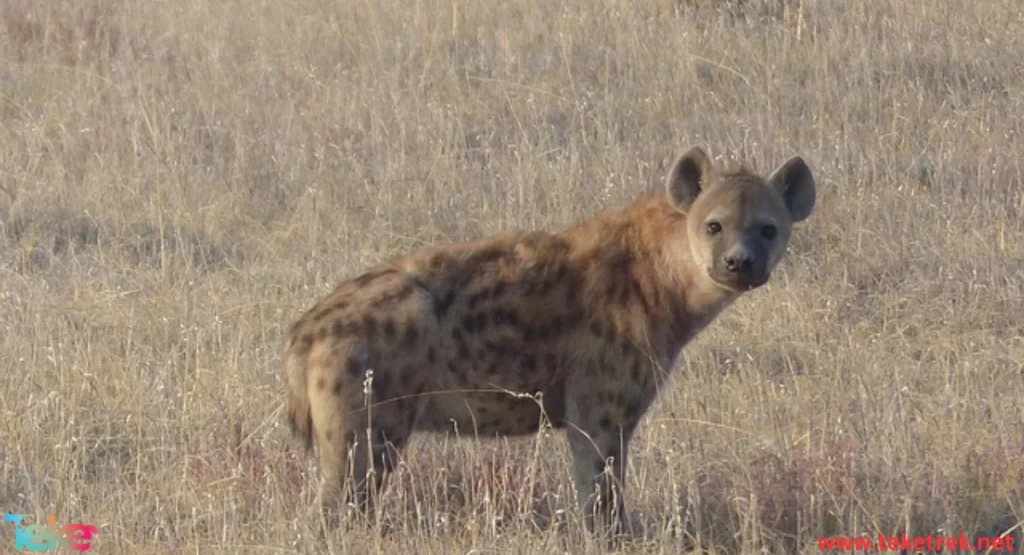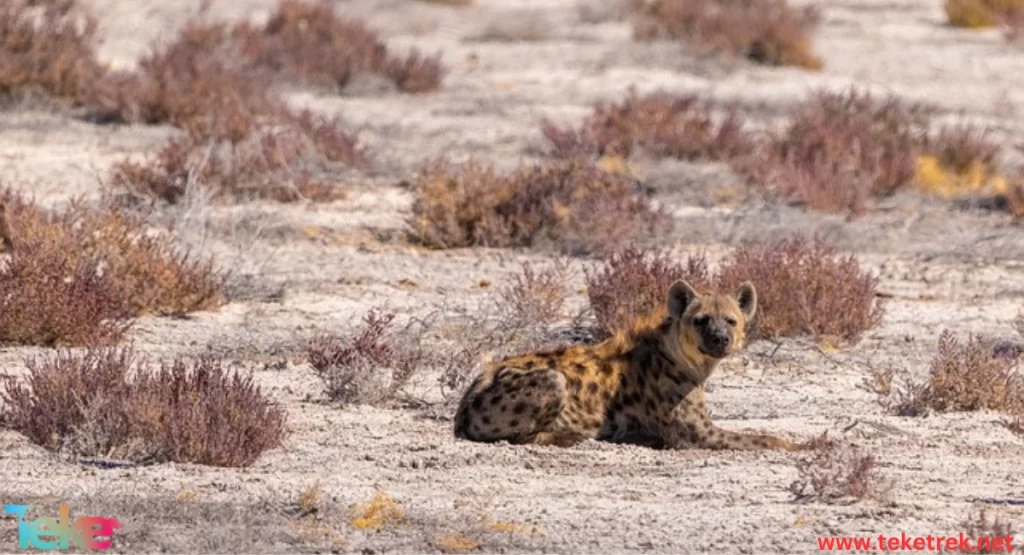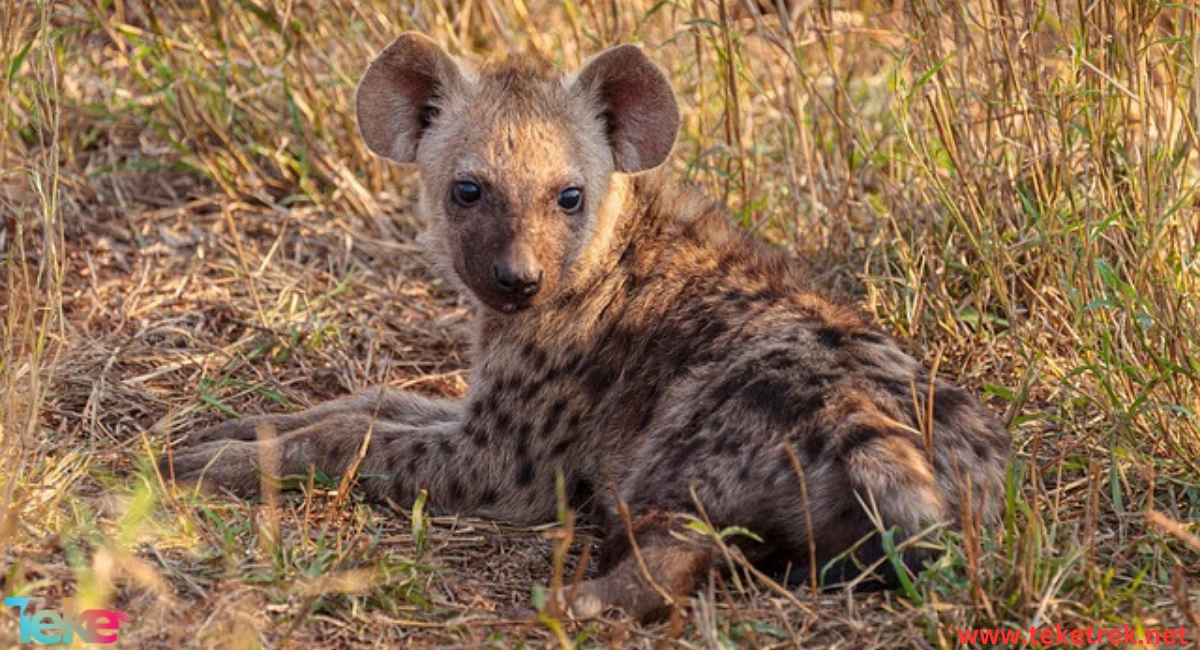The Spotted hyena is one of the largest and most famous types of hyenas.
Below on the teketrek website we talk more detail about this creature, what are its characteristics, behaviors, and food.
About the spotted hyena
The spotted hyena is one of the Hyaenidae family called the “laughing hyena.” The spotted hyena is characterized by the following characteristics:
- The body length of the spotted hyena from head to tail ranges from 95 to 150 cm, while its weight ranges from 45 to 70 kg.
- The female spotted hyena is larger than the male.
- The fur is in the form of circular spots of brown, gray or yellowish grey.
- At the anus of the spotted hyena there is a bag of bare skin that it uses to spread its scent, called the “anal gland.”
- The spotted hyena’s hind legs are shorter than its front legs, and it also has a large heart, which constitutes 1% of its body weight.
- The female has reproductive organs that resemble the male reproductive organs. For example: the clitoris in the female is similar to the penis in the male in that it can erect.
- It is connected to the central urogenital canal, through which she urinates, mates, and gives birth.
Spotted hyena habitats
- The spotted hyena is found in sub-Saharan Africa.
- You may find it in Cameroon, Nigeria, Burkina Faso, Ivory Coast, Mali, Senegal, and Sierra Leone.
- Spotted hyenas live in open, dry habitats, for example semi-desert areas, savannas and mountain forests.


Spotted hyena behaviors
The spotted hyena lives in competitive social groups called clans:
- The number of clan members ranges from 3 to 80 individuals, with females being dominant over males.
- Females spend their lives in the clan, while males leave when they reach sexual maturity and join another clan.
- Although hyenas live in clans, they only meet when hunting, defending territory, or at shared dens.
- The females are divided into higher-ranking and lower-ranking parts, with the cubs of the higher-ranking females inheriting their mother’s position in clan leadership.
- The spotted hyena has several vocal communications: it emits soft groans and squeals during greetings, it also makes shouting sounds during fighting, while it makes a calling sound when it feels frightened or excited.
- Male spotted hyena greets each other by smelling the penis, for 30 seconds.
Food of the spotted hyena
The spotted hyena is a predator that eats carcasses in addition to hunting, including zebras, gazelles, and buffalo.
- The spotted hyena eats all parts of its prey, including teeth, bones, fur, and internal organs.
- Some people believe that hyenas steal prey from lions, but this is not true. For example: In the Ngorongoro Crater, lions live on prey that they steal from hyenas.
Reproduction in the spotted hyena
Reproduction in the spotted hyena is seasonal, with the peak occurring during the rainy season.
- Hyenas do not establish permanent bonds, but the male courts the female to mate, with the female choosing the males who have recently joined the clan.
- The birth period lasts about 110 days.
- The female gives birth to young in a den that may be communal or private, and males may not participate in caring for the young.
- Young cubs have soft, dark brown hair, their eyes are open, and their fangs and incisors are small.
- Cubs are breastfed by their mothers for a period ranging from one to one and a half years, and they can move very quickly within a maximum period of ten days.
- While they can eat meat after 3 months, they also participate in hunting after their first year.
- The spotted hyena reaches sexual maturity when it is three years old.
Interesting facts about the spotted hyena
Among the most important facts about the spotted hyena:
- The spotted hyena, the largest of the hyenas in terms of size, is called the Dahhak.
- Although the external appearance of the hyena resembles a dog, it is more similar to cats, especially lions and tigers.
- The spotted hyena contributes to the ecological balance by eliminating weak and sick animals.
- Hyenas eat carrion because they can digest all the organs of the prey, including bones, horns, or even teeth.
- The circular spots of the young spotted hyena are darker and then quickly disappear as they grow older.


FAQ
- How powerful is a spotted hyena?
The spotted hyena is a strong and fast animal, capable of hunting its prey effectively.
- What is unique about spotted hyenas?
The unique thing about spotted hyenas is that they can run at speeds of up to 60 kilometers per hour, making them one of the fastest land animals.
- What does a spotted hyena eat?
The spotted hyena feeds mainly on small animals such as rabbits, birds and mice. It can also hunt deer and small antelope in some cases.
In short, the spotted hyena is a carnivorous animal that lives on the African continent mainly in groups.






